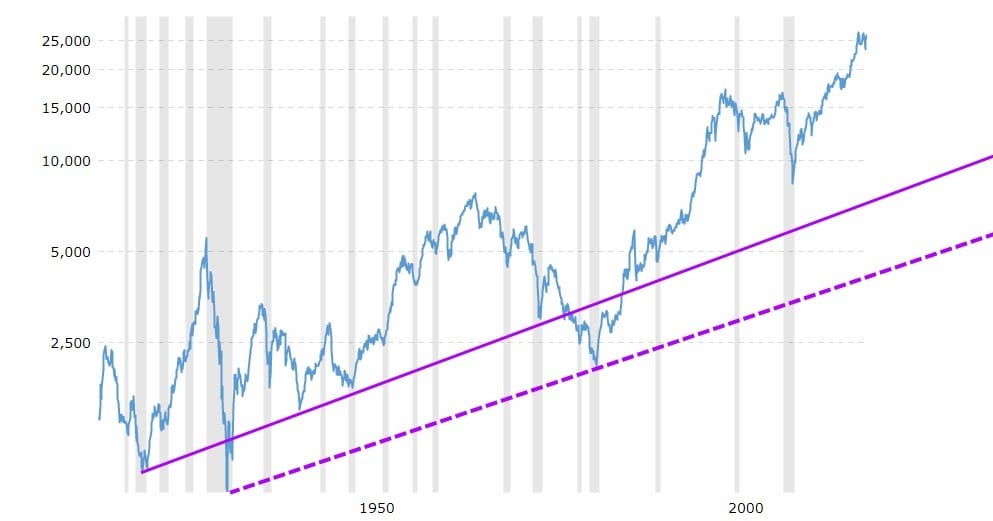
Dec 31, 2023
Introduction
In recent months, the stock market has been a turbulent arena, causing a ripple of nervousness among investors as prices experienced a significant decline. The prevailing question on many minds is whether this descent marks the elusive lowest point or if further challenges lie ahead. As we embark on this exploration, it’s crucial to acknowledge the prevailing mainstream view before unveiling the distinct perspective of the Tactical Investor.
The mainstream view, widely disseminated by conventional financial wisdom, often paints a picture that may not align with our contrarian approach. The tide of consensus, echoed by mainstream media, tends to mirror the collective mindset of the masses. Herein lies the dichotomy – the Tactical Investor’s unique perspective draws from Mass Psychology and technical analysis, offering an alternative lens to interpret market dynamics.
Now, buckle up for a journey that navigates the tumultuous waves of market sentiment and unveils the assertive stance of the Tactical Investor. Beyond the mainstream narratives, our exploration dives deep, uncovering insights that may challenge conventional thinking. Whether you’re a seasoned investor or new to the financial landscape, brace yourself for a compelling narrative that transcends the ordinary and asserts a perspective shaped by strategic insight and contrarian wisdom.
Recent Market Declines and the Lingering Question: Has the stock market bottomed out?
The S&P 500 index has dropped over 15% since the beginning of this year, marking an official bear market. However, the story behind the numbers reveals troubling economic trends that have investors wondering how further the market fall could extend.
Nearly every industry has been hit hard, but technology stocks have felt the most pain, with the Nasdaq tumbling over 25% from November highs. These steep losses were initially triggered by inflation, driving the Federal Reserve to accelerate interest rate hikes at a pace not seen in decades. As borrowing costs rise rapidly, expensive growth stocks reliant on future earnings are penalized the most in valuation adjustments.
The pullback has been widespread, yet the speed and ferocity of the tech wreck, in particular, raises eyebrows. During economic uncertainty, companies without consistent profits tend to get destroyed first as risk appetites fade. With inflation still running at over 8% annually, the threat of recession is rising as the Fed fights to gain control of consumer prices.
The uncertainty around how high rates must go to subdue inflation and the potential economic damage lie at the heart of investors’ unease. Some indicators already signalled stress, like weakening consumer sentiment and cooling housing data. Yet other areas, like the robust jobs market, continue powering ahead, complicating recession calls.
With such mixed signals, market participants wonder how deep any economic slowdown may materialize. A mild downturn curbing inflation without significant job losses could stabilise stocks sooner. However, a harsh recession risks further eroding corporate earnings and damaging balance sheets strained by higher borrowing expenses.
Until inflation shows clear signs of peaking, the Fed will likely remain aggressive even at the cost of economic harm. But markets are forward-looking and may bottom in anticipation of slower tightening before economic recovery takes hold. This disconnect means attempting to catch the ultimate low is a risk-fraught guess.
The burning question remains whether the current bear market has exhausted itself. While recent selling has been intense, paring year-to-date losses have proven elusive thus far. Selloffs of such speed and scope have historically tended to overshoot to the downside before also finding a bottom. With so many crosscurrents in play, clarity on how much farther stocks have yet to fall still seems a way off.
Factors Pointing to Further Declines and Lingering Uncertainty around Whether The Bottom Is Here
Despite the S&P 500 plummeting over 20% since the start of 2022, some market observers remain wary that further weakness lies ahead. Various risks persist that could prolong the current bear market and drive stocks to retest their lows.
Chief among concerns is inflation, which continues battering households without signs of decisive retreat. While some commodity prices like oil have eased, the overall CPI print rose 8.6% in May, squeezing consumers as wages fail to keep pace. The ongoing price pressures show the Fed still has its work cut out to anchor inflationary expectations through substantial rate hikes.
Indeed, Fed officials have signalled that they expect to maintain a restrictive policy stance deep into 2023 and beyond, as bringing inflation down remains the single priority. This duration of restrictive monetary policy elevates the chance of unintended consequences like an overtightening that deepens any economic downturn.
Even a mild recession could spell trouble for earnings. Consensus estimates assume profit growth will continue unabated, but these may prove too optimistic if demand wanes. Industries like housing-linked stocks would first feel the brunt of receding activity before ripple effects spread. If earnings revisions grow decidedly lower, fundamental valuations using forward estimates may not yet fully reflect deteriorating profitability.
Furthermore, geopolitical tensions from the Russia-Ukraine conflict to emerging headwinds in China maintain an uneasy backdrop globally. While such issues don’t directly drive markets, they introduce uncertainty that amplifies volatility. Without resolution, it’s difficult for sustained optimism to take root.
Considering all these mitigating circumstances, some professionals in the sector argue the selling may have further to run before stabilizing. While over 20% declines have likely priced in much bad news already, risks remain that could easily trigger another leg down before brighter days return. Only time will disclose whether the bottom is truly in sight or if more turbulence lies ahead. Continued vigilance seems prudent, given the present uncertainty.
Some Factors That Could Point to a Bottom Forming and Signal the Market May Have Finally Bottomed Out
While downside risks remain plentiful in current volatility, not every analyst is convinced the carnage will continue indefinitely. Some experts note glimmers that suggest attracting buying interest and gaining stability may be on the near-term horizon.
For one, the S&P 500 has now retraced over 20% since January highs. Such depths of selloffs in a short span have already discounted a great deal of negative news regarding soaring inflation, recession potential, and the associated pain for corporate profits and economic activity. Ever-diligent optimism may now see value for long-term investors in a cross-section of companies trading at tangible price discounts to fundamentals.
Additionally, while the inflation picture remains largely undesirable for policymakers and households alike, some commodity prices have started receding in a way that could foreshadow softening cost pressures. Both oil and certain industrial materials have backed off highs, sending tentative signals that snarled supply chains may be gradually untangling. If goods inflation proceeds to moderate further, it mitigates some of the imperative for the Fed to tighten forcefully.
The jobs market also highlights an area of ongoing robustness – a telling sign for any economy. As long as unemployment stays low and employers remain desperate to hire in this tight labour environment, even amid demand volatility, it supports consumption and bolsters the argument that the downturn may avoid morphing into something uglier than a mid-level recession.
Finally, history does indicate that relapse levels tend to find acceptance, and some degree of bargain-hunting ensues after bruising 20% plus drawdowns over compressed periods. While past performance can mislead, it hints at the relentless.
Entry Opportunities vs. Remaining Cautious: Views on Whether Now Is the Time to Buy or If It’s Still Too Early
Navigating turbulent equities requires carefully weighing opportunities against prudent risk management. On the one hand, significant share price retreats across many industries have undoubtedly thrown up attractive valuations for long-term investors. However, others caution against acting too hastily, given the remaining risks of turbulence.
Bulls argue that with the S&P 500 already down over 20% since the start of 2022, much pessimism regarding growth and profits has likely been priced in. From this perspective, certain companies now trade at tangible discounts to their future cash flow potential. Dollar-cost averaging into such perceived bargains currently could attain favourable average cost levels.
Nevertheless, bears maintain signs of stability and have yet to materialize conclusively. Elevated inflation, Fed tightening trajectory unknowns, and looming recession danger justify judicious patience. Index support breaks and technical indicators like the stochastic oscillator must signal oversold conditions reversing before new capital can reasonably expect an upside.
A middle ground considers gradual purchases alongside wait-and-see monitoring. Cash-heavy investors may feel comfortable initially seeding select positions or sectors viewed as durable through cycles. However, overcommitting too early risks catching a falling knife if the decline proves more protracted.
Ultimately, no consensus marks the low, and both camps present reasonable arguments. Prudent investors can thoughtfully extract insights from varying lenses to tailor customized, risk-managed plays based on their particular time horizons, risk tolerances, and portfolio needs. Broad assumptions should be avoided, as neutral fact-finding and flexibility will prove advantageous in this unclear landscape. While opportunities await the brave, downside protection remains a priority. Only ongoing observation across macro, technical and quantitative data points will provide more definition around whether current pressures have run their course or if further strain remains.
Has the Stock Market Hit Bottom: Insights from The Tactical Investor
So far, we have examined the prevailing consensus, but our perspective on whether a market has hit bottom diverges significantly. In a nutshell, when a market experiences a significant correction or crash from a long-term standpoint, we see it as a buying opportunity. Allow the chart below to illustrate this perspective – sometimes, a chart speaks a million words.

This long-term chart effectively dispels any concerns about the narrative surrounding whether the market has reached a bottom or not. Any investor with the foresight to use firm corrections or so-called crashes to buy top stocks would have profited significantly, making out like “bandits.” Therefore, the primary focus should be on building a portfolio of high-quality stocks before market pullbacks occur. This way, when they do, you’ll be well-prepared to act and potentially seize opportunities like a savvy “bandit” of the financial world.
Lost Opportunities in Market Crashes: A Contrarian’s Guide to Success
In the world of investing, the fear of market crashes often grips the minds of the masses. Many await the next big crash, believing it to be a golden opportunity. However, this mindset can be flawed, and the real opportunities might pass them by during the bullish market phases.
The mainstream narrative often focuses on market crashes as the ultimate chance to profit, but history tells a different story. More significant wealth is usually generated during bull runs. Contrarian investors understand that while it’s possible to make money by shorting the markets, the natural riches lie in embracing the optimism of a bull market.
Mass psychology plays a crucial role in this scenario. The masses, often influenced by fear, panic, and the desire to time the market, tend to make hasty decisions that lead to losses. Their track record of repeated mistakes, from the Tulip Mania to the housing bubble, underscores this point.
To navigate this, a contrarian approach is critical. It involves analyzing historical market data, studying how the masses reacted during previous market panics, and drawing valuable insights. Looking back at significant crashes, such as 1929, 1987, the Dot-com bubble, and the 2008 financial crisis, provides information.
The old saying goes, “Those who don’t learn from history are doomed to repeat it.” To avoid falling into this cycle, contrarian investors understand that true success comes from aligning with the prevailing market sentiment and being prepared to capitalize on opportunities throughout the market’s ebbs and flows.
Market Swings: Unleashing the Power of Opportunity
Market swings, especially the downturns, are more than just fluctuations – they equate to opportunities. These are the moments when astute investors see potential in the chaos.
In the stock market, emotion is the primary driving force. This emotional rollercoaster creates the peaks and valleys on financial charts. Understanding these emotions provides insight into the ideal course of action. When the masses are gripped by panic, it’s often the perfect moment to buy, and conversely, when euphoria reigns, it’s time to consider selling. This is where mass psychology comes into play, as it delves into the study of collective emotion.
The lesson from history is clear: when the masses panic, those who see the bigger picture find themselves in a position to seize opportunities. To study this fascinating subject further, delve into Mass Psychology and its intriguing connection with the markets.
While tools like a stock screener such as Finviz can help identify potential investments based on specific criteria, history and mass psychology remain the two vital areas that should be your focal points. Once you’ve grasped these, the rest becomes a straightforward journey towards successful investing.
Unlocking Market Cycles: Strategic Approaches Over Emotional Responses
Achieving success in investments hinges on deciphering market cycles. Each stage—accumulation, markup, distribution, and markdown—requires a calculated strategy rather than succumbing to emotional impulses. Astute investors grasp the significance of the accumulation phase, characterized by a quiet market, using research to make purchases when prices are at their lowest.
Consider the dot-com bubble: early investors identified potential in tech stocks during the accumulation phase, capitalizing on the subsequent growth surge in the markup phase. As the market peaked and transitioned into the distribution phase, prudent investors secured profits, while others, driven by greed, overlooked warning signals.
With the inevitable onset of the markdown phase, panic ensued, prices plummeted, and those swayed by fear incurred substantial losses. This cycle repeats across diverse markets, evident in patterns of human emotion and reactions, from the cryptocurrency surge and crash to recent market fluctuations driven by the pandemic.
To thrive, investors must transcend the emotional currents of the market. Acknowledge the euphoria of the markup phase, the avarice of distribution, and the fear of markdown. Maintain discipline, stay well-informed, and adopt a strategic approach. This serves as the blueprint for navigating market cycles and securing enduring financial prosperity.
Delectable Articles for the Inquisitive Reader.

Investor Sentiment and the Cross Section of Stock Returns: Exploring the Hot Connections

Investing for Teenagers: Laying the Foundation for a Financially Stable Future

Building a Resilient Investment Strategy with 40/60 Portfolio Diversification

IBM Stock Price Forecast 2024: Examining IBM’s Strategic Vision

US Stock Market Crash History: Lessons for Earning

What Is Price to Sales Ratio?: Understanding a Key Valuation Metric

Investor Sentiment in the Stock Market: Maximizing Its Use

Graceful Money Moves: 6 Powerful Tips on How to Manage Your Money

The Prestigious Path to Financial Wellness: How to Achieve Financial Wellness with Distinction

Where Does the Money Go When the Stock Market Crashes: A Contrarian Perspective

What is Inductive and Deductive Reasoning: Unveiling the Mystery

Savings Bonds 101: How Do Savings Bonds Work for Dummies

Finessing Your Finances: How to Manage Your Money When You Don’t Have Any

Copper Stocks to Buy: Seizing Wealth Opportunities In The Metal’s Market



